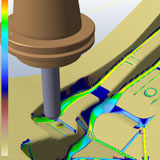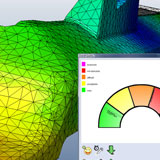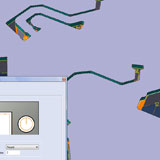




Vero launch VISI 19
Vero Software, a leading provider of CAD/CAM/CAE solutions for the tooling industry, are pleased to present the latest release of its flagship product VISI 19 through a number of UK open houses running over 5 days in July. Due for a Summer release, the latest product offering represents a continued focus on tool design and manufacture and includes a host of productivity enhancements including core 3D CAM development, 64Bit support, JT Open and further migration of PEPS capabilities onto the VISI platform.
VISI Modelling is the base application for all VISI products and V19 delivers CAD enhancements that include an updated GUI with improved user interaction, new blending capabilities, support for the widely adopted JT Open format, improved 3D annotation with geometric & surface tolerances, advanced profile offset and graphical texture mapping.
VISI Mould enhancements include an a new Assembly Tool Manager to handle multi-level tool structures, and provide the ability to generate specific tree hierarchy structures for the creation of partial BOM lists. VISI Flow development include a new part quality tool with potential remedy suggestions for each problem area and improved filling analyses and flow balancing due to the fine tuning of melt compressibility at end of the filling phase.
For sheet metal stamping, VISI Progress enhancements include three new dedicated routines to manage complex springback based on results from CMM machines, 3rd party FEA systems and bend section geometry. Each routine includes skimming capabilities to reduce point clutter and allows the operator to define an additional percentage to over compensate for the springback deformation.
CAM enhancements focus on delivering new CAM algorithms, optimised calculation times, 64Bit support and improving the overall usability with improvements to feature recognition and post processor performance. New cutting methods include :
Deep Cavity Machining - An intelligent automation of existing CAM strategies for machining deep cavities. Typically, using the longest tool to machine the complete cavity will require smaller depths of cut and reduced feeds. Deep Cavity Machining is able to split the cavity into multiple depths based on collision checking between the piece and tool / holder. In this case, the operator is able to define different tool lengths for same operation, providing greater rigidity, reduced vibration & increase tool life. By automatically splitting the Z levels, different step down & step over parameters can be defined for each Z range.
Core Roughing - A new roughing algorithm has been developed with an improved toolpath shape when working from outside a component. The new toolpath will dramatically reduce the number of rapid movements, allow the use of more than 50% step over of the flat area of the cutter and improve calculation time. The result is a flowing toolpath that allows the machine to run near to its maximum potential when machining core components.
HM Constant Z - This toolpath is very similar to steep & shallow and combines all the benefits of a traditional constant Z operation with a highly sophisticated 3D pocketing routine for planar areas. The new CAM algorithm uses a 2D pocketing projection for the intermediate planar areas instead of a true 3D stepover and the results produce dramatic time savings.
Rib Machining - This new strategy has been designed specifically to resolve the issue of machining very thin rib walls. The typical approach of using multiple operations runs the risk of damaging the part, specifically towards the end of the process when the rib is subjected to high frequency vibrations and micro-flexes.
To overcome these issues the Rib Machining algorithm combines the new roughing algorithm with a new finishing routine to ensure the highest part-rigidity possible by roughing and finishing each level individually working down the model.
VISI PEPS-Wire development has continued with new technology added and further migration of historic PEPS capabilities to the new VISI platform. These include slug retention, feature recognition for land and taper features, CT Expert integration, VDM file import and pocketing with finishing allowance, a new routine that allows the user to partially pocket an aperture by specifying the remaining stock left to cut. This dramatically improves wire usage by keeping fresh air cutting to a minimum.





